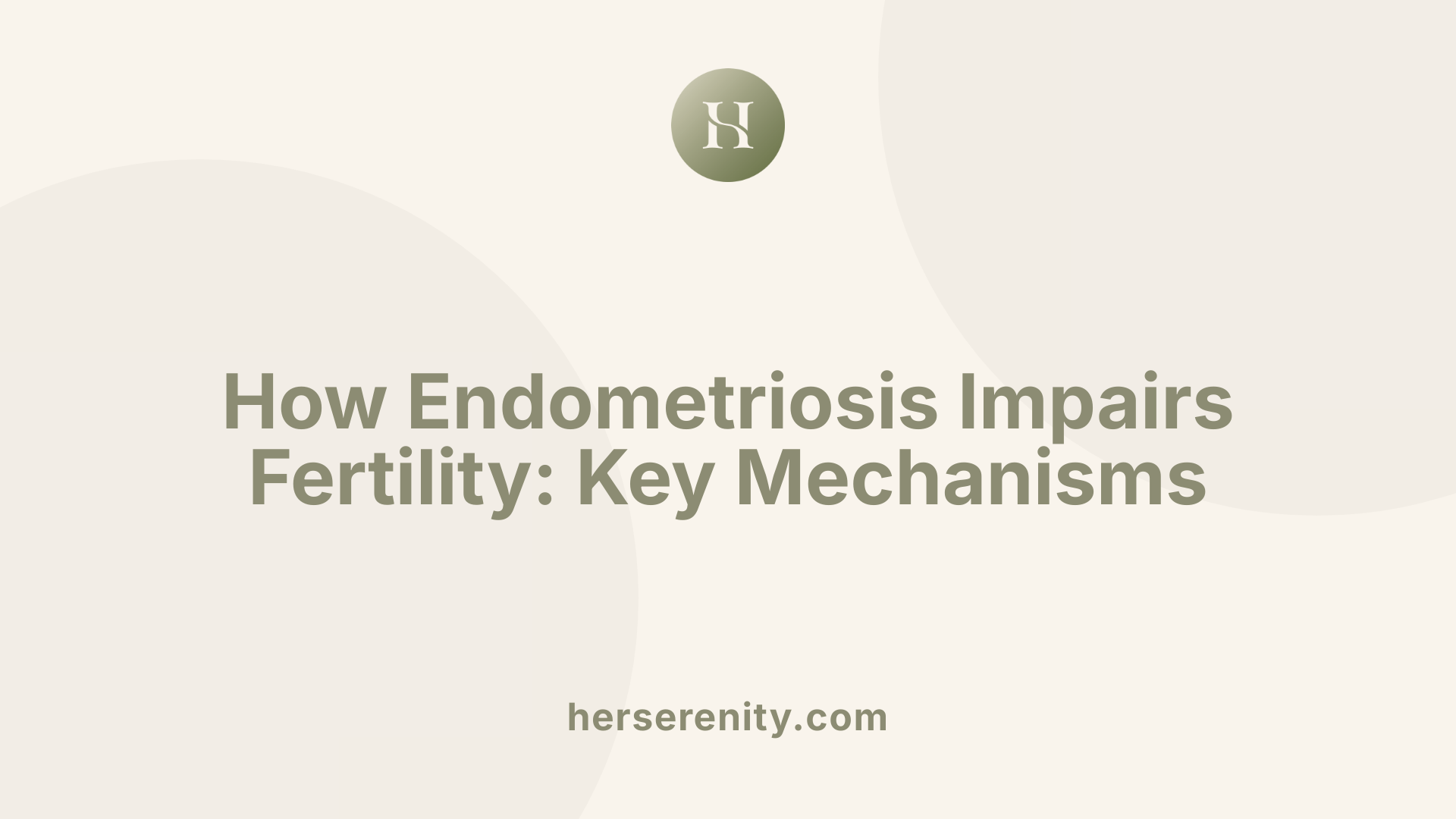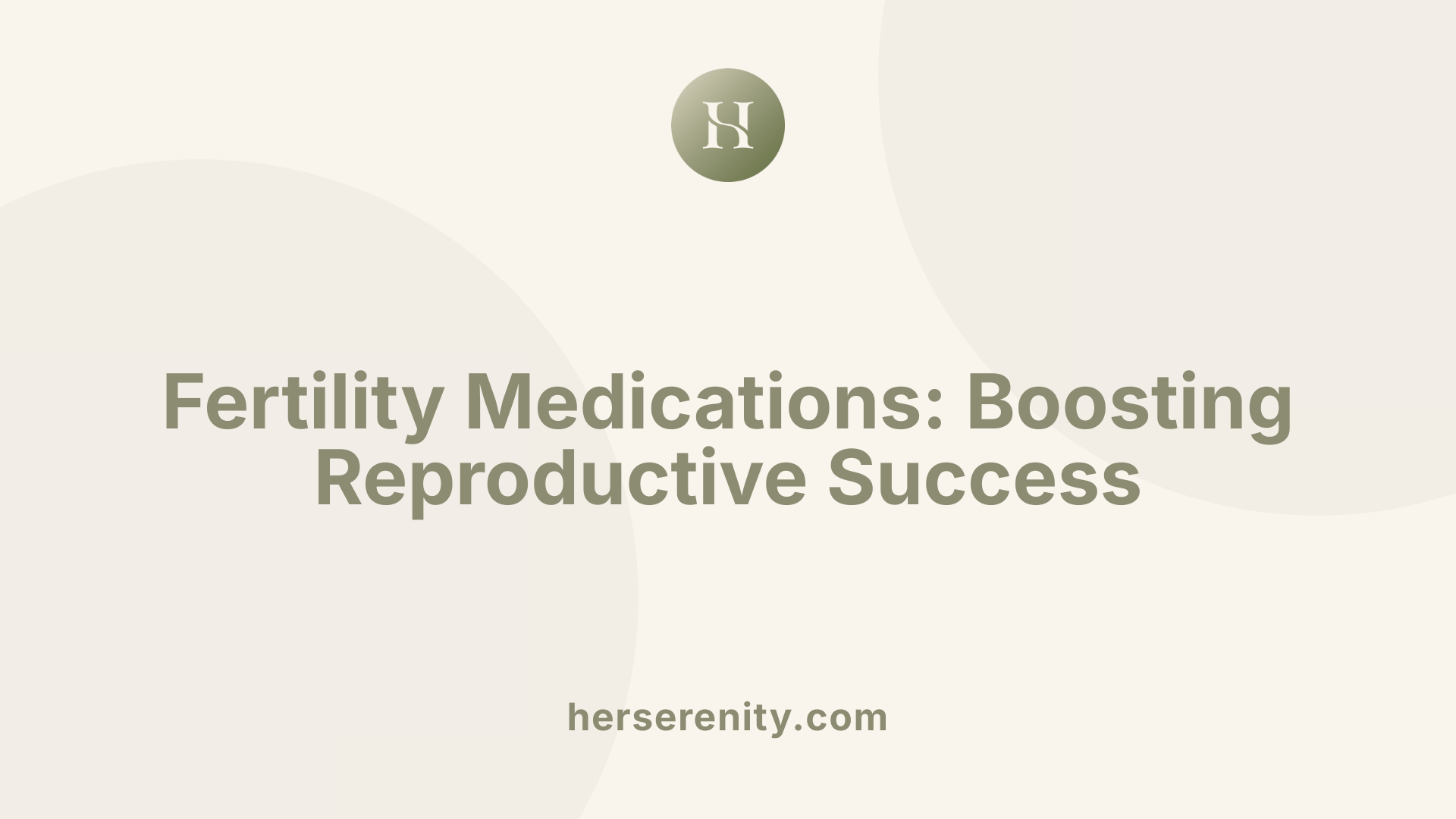Understanding the Intersection of Endometriosis and Fertility
Endometriosis, a chronic gynecological condition characterized by the growth of uterine-like tissue outside the uterus, profoundly affects millions of women worldwide. Not only can it cause debilitating pain and menstrual disturbances, but it is also strongly linked with infertility. This article explores the symptoms, diagnostic approaches, and comprehensive treatment strategies for endometriosis, with a special focus on its impact on reproductive health and fertility outcomes.
What Is Endometriosis and How Does It Affect Fertility?

Definition and Prevalence of Endometriosis
Endometriosis is a chronic condition characterized by the growth of tissue resembling the uterine lining outside the uterus. This tissue implants mainly within the pelvis and can cause inflammation, pain, and scarring. It affects about 10% of women of reproductive age worldwide, which translates to approximately 200 million people. The exact cause remains unclear, although several theories exist.
Common Sites of Endometrial Implants
Endometriosis lesions commonly occur in the space behind the uterus, on the ovaries, fallopian tubes, and pelvic peritoneum. Less frequently, the disease affects areas such as the rectum, bladder, intestines, diaphragm, vagina, and very rarely the lungs. These ectopic implants trigger local inflammatory reactions and formation of scar tissue.
Symptoms Including Pain and Heavy Bleeding
Typical symptoms include pelvic pain that can be severe, heavy or irregular menstrual bleeding, pain during intercourse, and pain associated with bowel movements or urination. Many women also experience chronic abdominal or back pain and fatigue. These symptoms often profoundly affect quality of life.
Impact on Fertility and Reproductive Anatomy
Endometriosis distorts pelvic anatomy and produces inflammation and adhesions that interfere with the normal function of reproductive organs. This disruption impairs the passage of sperm and eggs and affects egg quality and embryo implantation. Approximately 30-50% of women with endometriosis experience infertility, making it a leading cause of reproductive difficulties globally.
How Endometriosis Relates to Infertility
By causing mechanical obstruction and altering the local hormonal and immune environment, endometriosis reduces natural conception rates from approximately 10-20% per month in unaffected women to 1-10% per month in women with the disease. It impacts gamete transport, sperm motility, and creates a uterine lining less receptive to embryo implantation. Thus, endometriosis is directly linked to reduced fertility and challenges in conceiving naturally.
Recognizing the Symptoms and Complications of Endometriosis
What are the symptoms of endometriosis?
Endometriosis can cause a variety of symptoms that often significantly affect daily life. Common complaints include severe pelvic and abdominal pain, particularly during menstrual periods. Women often experience painful cramps that may be heavier or longer than usual, alongside irregular spotting between periods.
Pain during sexual intercourse is another frequent symptom, along with discomfort or pain during bowel movements or urination. This pain can also extend to the lower back and abdomen, making normal activities challenging.
Heavy menstrual bleeding is common, sometimes accompanied by spotting. Fatigue and nausea may also be experienced, contributing to overall physical discomfort.
What complications can arise from endometriosis?
Beyond painful symptoms, endometriosis can lead to serious complications. The growth of endometrial-like tissue outside the uterus may cause inflammation and scar tissue, potentially interfering with bowel and bladder function. In rare cases, the condition can affect the diaphragm or lungs, leading to breathing difficulties.
How does endometriosis affect quality of life?
The persistent pain and physical symptoms often lead to emotional distress, including anxiety and depression. The chronic nature of the illness, coupled with symptoms like pain during daily activities and sexual intimacy, can reduce quality of life and cause social and psychological challenges.
Effective management focuses not only on symptom relief but also on supporting the emotional well-being of those affected. Multidisciplinary care is often essential to address both the physical and mental health impacts of this complex condition.
Diagnostic Approaches: From Clinical Assessment to Laparoscopy

How is endometriosis diagnosed?
The diagnosis of endometriosis begins with a comprehensive medical history and a detailed pelvic exam. These clinical assessments help identify symptoms such as pelvic pain, heavy periods, and infertility that suggest the presence of the disease.
Imaging techniques play an important role in supporting diagnosis. Transvaginal ultrasound and magnetic resonance imaging (MRI) are commonly used to detect ovarian cysts (endometriomas) and deep infiltrating endometriosis. However, these methods have limitations as superficial endometriosis lesions typically cannot be visualized through imaging.
Due to these challenges, laparoscopy remains the gold standard for definitive diagnosis. This minimally invasive surgical procedure enables direct visualization of endometriotic implants and adhesions within the pelvic cavity. During laparoscopy, surgeons can perform targeted biopsies, which provide histopathological confirmation of endometriosis.
Staging of the disease is also conducted during laparoscopy, based on the location, amount, and severity of endometrial implants and scar tissue. Classifications such as the American Society for Reproductive Medicine (ASRM) system help guide treatment decisions and prognosis.
In summary, diagnosing endometriosis is a multi-step process involving clinical evaluation, imaging studies, and surgical confirmation through laparoscopy with biopsy, which remains crucial for accurate diagnosis and appropriate management.
Mechanisms by Which Endometriosis Impairs Fertility

How does endometriosis affect fertility?
Endometriosis impairs fertility through several complex mechanisms. One major factor is the anatomical disruption of the pelvic cavity. The growth of endometrial-like tissue outside the uterus causes scar tissue and adhesions that can distort pelvic anatomy. This can block or interfere with the fallopian tubes, disrupting the normal movement of eggs and sperm, and reducing the chances of fertilization.
Inflammation and immune dysregulation
The presence of endometriotic lesions triggers chronic inflammation in the pelvic area. This inflammation leads to the release of abnormal concentrations of inflammatory cytokines and immune cells. These changes alter the hormonal environment around the eggs and create an unfavorable setting for conception. Immune dysregulation may also impair normal sperm function and contribute to an environment hostile to sperm and embryos.
Effects on egg quality and implantation
Endometriosis negatively affects egg quality by creating a toxic environment due to oxidative stress and inflammation. This can reduce oocyte viability and embryo quality. Furthermore, the altered pelvic environment interferes with embryo implantation. Studies show that gene expression in the uterine lining is disrupted, including reductions in HOXA10 and Wnt pathway genes, which are essential for preparing the endometrium to accept an embryo.
Alterations in endometrial receptivity
The condition causes progesterone resistance and increases inflammatory and angiogenic factors in the endometrium. These changes prevent proper preparation of the uterine lining for implantation. Consequently, even if fertilization occurs, the embryo may fail to successfully implant and develop.
Impact on sperm function and embryo transport
Endometriosis impairs sperm motility due to the inflammatory pelvic fluid environment. Additionally, adhesions around the fallopian tubes and uterus can slow or block embryo transport towards the uterus. This mechanical and biochemical disruption further decreases fertility chances.
Combined, these mechanisms explain why approximately 30-50% of people with endometriosis experience infertility, making it one of the leading causes of infertility in women of reproductive age.
| Mechanism | Description | Impact on Fertility |
|---|---|---|
| Anatomical Disruption | Scar tissue and adhesions disturb pelvic anatomy and tubal function | Blocks egg and sperm movement, reduces fertilization rates |
| Inflammation & Immune Dysregulation | Chronic inflammation alters hormonal & immune environment | Damages egg quality, impairs sperm function |
| Egg Quality & Implantation | Oxidative stress and inflammatory mediators reduce oocyte/embryo viability | Lowers embryo viability and implantation success |
| Endometrial Receptivity Alterations | Progesterone resistance, altered gene expression | Prevents effective implantation |
| Sperm Function & Embryo Transport | Impaired sperm motility and disrupted transport due to adhesions and inflammation | Decreases fertilization and embryo migration |
Medical Management of Endometriosis: Pain Relief and Hormonal Control
What medical treatments help manage endometriosis symptoms?
Medical treatments for endometriosis primarily focus on relieving pain and controlling hormonal influences that drive the growth of endometrial-like tissue outside the uterus.
Use of NSAIDs for pain management
Nonsteroidal anti-inflammatory drugs (NSAIDs) are commonly used for their pain-relieving and anti-inflammatory properties. They help reduce pelvic pain, menstrual cramps, and discomfort during intercourse or bowel movements associated with endometriosis.
Hormonal therapies
Hormonal treatments aim to suppress or regulate the hormones that stimulate endometrial tissue growth. These include:
- Combined oral contraceptives: Pills containing estrogen and progestin to reduce menstrual bleeding and suppress lesion growth.
- Progestins: Hormone therapy that counteracts estrogen and helps reduce inflammation.
- Gonadotropin-releasing hormone (GnRH) agonists and antagonists: Drugs that induce a temporary menopause-like state by lowering estrogen levels, thereby shrinking endometriotic lesions and alleviating symptoms.
Limitations of hormonal therapy for fertility enhancement
While hormonal therapies are effective in symptom control, they do not improve fertility and may actually suppress ovulation, thus limiting chances of conception during treatment. Fertility-focused treatments usually require different approaches.
Importance of individualized treatment plans
Treatment choice depends on the individual's symptom severity, age, fertility goals, and tolerance to side effects. Some patients benefit from a combination of therapies, while others may require switching medications if symptoms persist.
Symptom recurrence after stopping treatment
Symptoms often return once hormonal therapies are discontinued, highlighting the chronic nature of the disease and the need for ongoing management.
Overall, medication plays a central role in managing endometriosis symptoms but must be carefully tailored and monitored to balance pain relief and reproductive desires.
Surgical Interventions: Enhancing Fertility and Symptom Control

How does surgery help women with endometriosis and infertility?
Surgical treatment, primarily through laparoscopy, plays a crucial role in managing endometriosis-related infertility and symptom relief. The procedure involves excision or ablation of endometriotic lesions and removal of endometriomas (cysts), aiming to restore normal pelvic anatomy. This restoration can reduce inflammation and adhesion formation, thereby improving the environment for egg and sperm interaction.
What are the indications for surgery in fertility treatment?
Surgery is usually considered when conservative medical therapies such as hormonal treatments or pain medications fail to control symptoms or when infertility is a prominent concern. Women with minimal to moderate endometriosis (Stages I and II) often benefit most from surgical removal as it can increase the chances of spontaneous conception. In cases where pain severely affects quality of life or large endometriotic cysts compromise ovarian function, surgery is also indicated.
What are the potential benefits on live birth rates in mild to moderate disease?
Evidence suggests that surgical intervention in early stages of endometriosis can improve live birth rates. Studies show that laparoscopic excision or ablation of implants may increase successful pregnancy rates by approximately 8.6% per treated patient. Surgery facilitates the removal of scar tissue and enhances pelvic anatomy, supporting natural conception more effectively than medical therapy alone.
What are the risks and chance of symptom recurrence post-surgery?
While surgery can offer significant benefits, it is not without risks. Potential complications include damage to ovarian reserve, particularly when removing cysts, and surgical risks such as infection or bleeding. Additionally, symptoms and lesions may recur, sometimes necessitating repeat interventions. Therefore, surgery should be personalized based on disease severity and reproductive goals.
When is hysterectomy considered in endometriosis treatment?
Hysterectomy, sometimes coupled with removal of ovaries, is considered a last resort for severely affected individuals with refractory pain and extensive disease unresponsive to other treatments. This radical approach inevitably results in infertility and early menopause, so it is reserved for cases where symptom management and fertility preservation are no longer priorities or viable.
Together, these surgical interventions offer hope for women with endometriosis to alleviate pain and improve fertility, especially when tailored within a multidisciplinary treatment plan.
Fertility Treatments for Endometriosis-associated Infertility
What are common medical treatments available to assist individuals and couples with conception?
Endometriosis-associated infertility is managed with several medical fertility treatments aimed at enhancing ovulation and overcoming anatomical or immunological barriers. Ovulation induction medications, such as clomiphene citrate, are frequently prescribed to stimulate the ovaries to produce viable eggs. These medications help improve the chances of conception, especially in women with minimal to moderate endometriosis.
How effective is intrauterine insemination (IUI) for endometriosis?
Intrauterine insemination (IUI) is often combined with ovulation induction to increase pregnancy rates. Success rates of IUI in women with endometriosis generally range between 15% and 20% per treatment cycle. However, outcomes can vary widely depending on the severity of endometriosis and other fertility factors.
What is the role and effectiveness of in vitro fertilization (IVF)?
IVF stands out as the most effective fertility treatment for women with moderate to severe endometriosis or those who do not conceive following surgery and IUI. IVF involves ovarian stimulation to retrieve eggs, fertilization outside the body, and embryo transfer to the uterus. Pregnancy and live birth rates with IVF for endometriosis patients are comparable to women with other infertility causes, although success rates typically decline with increasing age.
How does pre-treatment with GnRH agonists influence IVF outcomes?
Pre-treatment with gonadotropin-releasing hormone (GnRH) agonists before initiating IVF has been shown to improve pregnancy rates in women with advanced endometriosis. The hormonal suppression appears to reduce inflammation and endometrial lesions, optimizing the uterine environment for implantation and enhancing IVF success.
What is the broader role of assisted reproductive technologies (ART) in managing endometriosis-related infertility?
Assisted reproductive technologies, including IUI and IVF, form the cornerstone of infertility management in endometriosis, especially when surgical treatments have limited success or are contraindicated. Fertility clinics typically offer a spectrum of services including evaluation, ovulation induction, surgical correction when necessary, multiple ART procedures, and fertility preservation options such as embryo and oocyte cryopreservation. This multidisciplinary approach helps tailor fertility care to each patient's unique needs, improving overall reproductive outcomes.
| Treatment Method | Description | Success Rate/Considerations |
|---|---|---|
| Clomiphene Citrate | Ovulation induction medication | Improves ovulation; variable pregnancy success |
| Intrauterine Insemination | Placement of sperm directly into uterus after ovulation induction | 15-20% per cycle in endometriosis patients |
| In Vitro Fertilization (IVF) | Egg retrieval, fertilization, and embryo transfer | Most effective for advanced cases; age-dependent |
| GnRH Agonist Pre-treatment | Hormonal suppression before IVF | Enhances IVF success in advanced endometriosis |
| Assisted Reproductive Technologies (ART) | Comprehensive fertility support including IUI, IVF, surgery, preservation | Tailored treatment enhances fertility outcomes |
How Fertility Medications Work to Enhance Reproductive Health

How do fertility medications work to enhance reproductive health?
Fertility medications primarily stimulate or regulate ovulation by influencing hormone levels such as follicle-stimulating hormone (FSH) and luteinizing hormone (LH). These hormones encourage the development and maturation of ovarian follicles, increasing the likelihood of releasing one or more eggs during a cycle.
What are common fertility medications and how do they work?
- Clomiphene citrate: An oral medication that blocks estrogen receptors in the brain, tricking the body into producing more FSH and LH to stimulate ovulation.
- Letrozole: An aromatase inhibitor that reduces estrogen production, indirectly promoting increased FSH release and follicle growth.
- Injectable gonadotropins: These include FSH and human menopausal gonadotropin (hMG), directly stimulating the ovaries to produce multiple follicles.
How are injectable gonadotropins used?
Injectable gonadotropins are often used when oral medications are ineffective or in assisted reproductive technologies (ART) like intrauterine insemination (IUI) and in vitro fertilization (IVF). They require careful dosing and monitoring due to the increased risk of ovarian hyperstimulation syndrome (OHSS) and multiple pregnancies.
Why is monitoring important during treatment?
Ultrasound monitoring and blood tests help track follicle growth and hormone levels, allowing physicians to adjust medication doses. Monitoring optimizes treatment safety and effectiveness, reducing risks of complications such as overstimulation or poor response.
How do fertility medications combine with assisted reproductive procedures?
Medications may be used alone to induce ovulation or alongside IUI or IVF to boost egg numbers and improve pregnancy chances. In IVF, gonadotropin stimulation maximizes the number of retrievable eggs, enhancing the success rates of fertilization and embryo transfer.
The tailored use of these medications, coupled with clinical monitoring, forms a cornerstone in managing infertility and improving reproductive outcomes.
Factors Couples Should Consider When Choosing Fertility Treatments
What factors should couples consider when choosing a fertility treatment?
Choosing an appropriate fertility treatment involves a multifaceted decision-making process influenced by various personal and medical factors.
Effectiveness and Safety of Treatments
The success rates of fertility treatments vary, with options like IVF generally offering higher pregnancy chances, especially in advanced endometriosis cases. Safety is paramount; some treatments, such as surgery, carry risks including damage to ovarian reserve, while medical therapies might affect hormone levels or pregnancy planning.
Age and Health Status Impact on Fertility
Age is a critical determinant since fertility typically declines with age. Women in their 20s and early 30s tend to have better treatment outcomes compared to those in their late 30s and 40s. Additionally, overall health — including presence of endometriosis severity, ovarian reserve, and other medical conditions — influences which treatments are advisable.
Personal Values and Financial Considerations
Couples must reflect on their values about family planning and medical interventions. Financial factors play a significant role, as treatments like IVF can be costly and not always covered by insurance. Balancing treatment benefits against costs and emotional readiness is essential.
Importance of Lifestyle Modifications
Incorporating lifestyle changes, such as smoking cessation, a balanced diet, and reducing stress, can improve fertility prospects and complement medical treatments.
Access and Insurance Coverage Issues
Availability of fertility treatments varies by geographic location and healthcare systems. Insurance coverage for treatments like IUI, IVF, or surgery also differs widely, potentially limiting options.
Collaborative Decision-Making with Providers
Effective fertility treatment planning requires open dialogue with reproductive endocrinologists or gynecologists. Providers assess medical history, age, disease stage, and goals to suggest personalized options. Shared decision-making ensures that couples' preferences, concerns, and financial situations are respected while maximizing chances of successful conception.
By carefully considering these factors, couples facing endometriosis-related infertility can make informed decisions tailored to their unique circumstances, improving both outcomes and well-being.
Emerging and Future Directions in Endometriosis and Fertility Care

What Are Some Recent Advancements in Reproductive Health Treatments?
Recent developments in reproductive health specifically targeting endometriosis and fertility are diverse and promising. Novel therapies such as stem cell treatments and immune modulation therapies are being explored to combat the root causes of endometriosis. These approaches aim to repair damaged tissue, reduce inflammation, and modify immune system dysfunction associated with the disease, potentially improving fertility outcomes.
Advancements in fertility preservation also offer new hope. Techniques like ovarian tissue cryopreservation expand options for women who wish to safeguard their fertility prior to surgery or treatment. This method allows for preservation of reproductive potential even in cases where ovarian reserve may be compromised.
Improvements in diagnostic tests and laboratory technologies bring greater precision to fertility care. For example, the Endometrial Receptivity Array (ERA) is a diagnostic tool that evaluates the optimal timing for embryo implantation, enhancing the success rates of assisted reproductive technologies (ART). Lab automation, including microfluidics, is refining embryology procedures to improve embryo culture and selection.
How Do Personalized Multidisciplinary Approaches Benefit Patients?
A personalized, multidisciplinary approach integrates expertise from reproductive endocrinologists, surgeons, immunologists, and fertility specialists to tailor treatments based on the patient’s disease severity, reproductive goals, and overall health. This collaboration allows for comprehensive management addressing pain control, surgical intervention, hormonal therapy, and assisted reproduction, maximizing fertility outcomes and quality of life.
What Is the Potential of Molecular-Targeted Therapies?
Molecular-targeted therapies represent an exciting frontier by focusing on specific pathways involved in endometriosis pathogenesis. These include agents that modulate inflammatory cytokines, angiogenesis, and hormonal resistance within endometrial tissue. Such targeted treatment could improve symptom control and fertility prospects while minimizing systemic side effects.
Together, these advancements mark a shift toward more effective, patient-centered care in endometriosis and fertility management, offering improved hope for individuals affected by this challenging condition.
Navigating Fertility with Endometriosis: Hope Through Comprehensive Care
Endometriosis remains a complex condition with significant impact on pain, quality of life, and fertility. Timely diagnosis using a combination of clinical assessment and laparoscopy is crucial to tailor individualized treatment plans. While medical and surgical therapies focus on symptom relief and restoring reproductive function, assisted reproductive technologies like IVF play a vital role in overcoming infertility associated with endometriosis. Advances in reproductive medicine and a multidisciplinary approach offer hope for many women desiring conception, emphasizing that with appropriate care, pregnancy is achievable despite endometriosis.
References
- Endometriosis: Causes, Symptoms, Diagnosis & Treatment
- Endometriosis and Its Impact on Fertility
- Endometriosis and Infertility: A review of the pathogenesis ...
- Endometriosis - Diagnosis and treatment
- Endometriosis
- Endometriosis
- Endometriosis and Fertility: How Treatment Options May ...
- Endometriosis and infertility: a committee opinion (2012)
- Endometriosis and Fertility
- Endometriosis and infertility: pathophysiology, treatment ...





